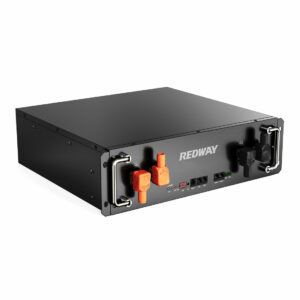What is the backup time for a 48 volt 100 Ah battery?
A 48V 100Ah battery provides up to 4.8kWh of energy (48V × 100Ah). Backup time depends on the load: a 500W device runs ~8-9 hours accounting for 85% inverter efficiency and 80% depth of discharge. Real-world factors like temperature, battery chemistry (LiFePO4 vs. lead-acid), and load fluctuations shorten runtime by 10–25%.
How is backup time calculated for a 48V 100Ah battery?
Backup time is derived by dividing usable energy (kWh) by load (kW). For a 48V 100Ah LiFePO4 battery: 48V × 100Ah × 0.9 (DoD) × 0.9 (inverter efficiency) = 3.9kWh. A 400W load yields ~9.7 hours. Lead-acid variants last 4-5 hours due to 50% DoD limits.

To calculate backup time, use: Backup (hours) = (Voltage × Ah × DoD × Inverter Efficiency) ÷ Load (Watts). For example, a 48V 100Ah LiFePO4 battery powering a 600W fridge: (48 × 100 × 0.9 × 0.9) / 600 = 6.48 hours. But what if the load isn’t constant? Devices like refrigerators cycle on/off, so runtime may stretch 20% longer. Pro Tip: Use lithium batteries for higher DoD—lead-acid’s 50% limit slashes usable energy by half. Always derate calculations by 10–15% for aging or temperature dips below 15°C. Think of it like a gas tank: higher “pressure” (voltage) and “volume” (Ah) let you drive longer, but hills (load spikes) drain it faster.
What factors reduce 48V 100Ah battery backup time?
Key factors include high loads (>1kW), low temperatures, aging cells, and partial state-of-charge cycles. Inverter inefficiency (as low as 80%) and voltage sag under heavy loads can cut runtime by 30% versus ideal lab conditions.
Beyond basic math, real-world variables bite hard. Temperature is a silent killer: at -10°C, lithium batteries lose 25% capacity. Aging cells degrade too—after 2,000 cycles, a LiFePO4 pack holds ~80% of its original 100Ah. Partial charging (e.g., frequent 50%→80% cycles) also induces “capacity knee” effects. Then there’s inverter losses: a 48V→120VAC conversion wastes 10–15% as heat. Practically speaking, a 48V 100Ah system rated for 8 hours at 500W might deliver 6.5 hours in winter. Pro Tip: Oversize your battery bank by 20% to offset aging and temperature losses. Imagine a water pipe: kinks (inefficiencies) and leaks (self-discharge) mean less reaches the end.
| Factor | Impact on Runtime | Mitigation |
|---|---|---|
| High Load (≥1kW) | -40% | Use load-shedding circuits |
| Low Temp (0°C) | -30% | Insulate battery compartment |
| Aged Cells (2k cycles) | -20% | Replace cells at 80% SoH |
How does battery chemistry affect 48V 100Ah backup duration?
LiFePO4 lasts 2-3x longer than lead-acid per charge due to 90% DoD vs. 50%. A 48V 100Ah LiFePO4 delivers ~4.3kWh usable; AGM provides 2.4kWh. Lithium also maintains voltage stability under load, preventing early low-voltage shutdowns.
Chemistry dictates energy accessibility. Lead-acid batteries voltage sags rapidly under high loads—a 48V AGM bank at 100A load might drop to 43V, triggering inverters to shut off prematurely. Lithium’s flat discharge curve (48V→46V) sustains power delivery until ~10% SoC. Plus, lithium handles partial charges without sulfation damage. For telecom towers using 48V systems, switching from VRLA to LiFePO4 can double backup time from 8 to 16 hours. But what about cost? Lithium’s upfront price is 2x higher, but 10-year lifespan beats lead-acid’s 3-5 years. Pro Tip: For mission-critical backup, lithium’s cycle life and DoD justify the investment. It’s like comparing a sprinter (lead-acid) to a marathoner (LiFePO4)—both store energy, but endurance differs wildly.
| Chemistry | Usable Energy | Cycle Life |
|---|---|---|
| LiFePO4 | 4.32kWh | 3,500+ |
| AGM | 2.4kWh | 500 |
| Gel | 2.16kWh | 800 |
RackBattery Expert Insight
FAQs
Can a 48V 100Ah battery power a house?
Yes, but runtime depends on load. A 48V 100Ah LiFePO4 (4.8kWh) can run essentials (fridge, lights) for 8–12 hours. For whole-home backup, combine multiple batteries or add solar.
How to extend 48V battery backup time?
Reduce load (LED lights, efficient appliances), maintain 20°C operating temps, and use lithium chemistry. Parallel batteries for longer runtime—two 48V 100Ah units double capacity.
Does cold weather affect lithium backup time?
Yes. At -10°C, capacity drops 25%. RackBattery’s heated cabinets prevent this, sustaining 95% runtime in freezing conditions.



